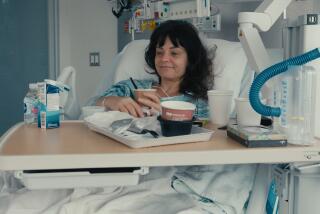Fuzzy facts on kidney disease
- Share via
“Men in Trees, A Tale of Two Kidneys”; ABC; March 26; 10 p.m.
The premise: Up in the wilderness of Elmo, Alaska, handyman Cash (played by Scott Elrod) loses consciousness and is rushed to the hospital, where his doctor discovers he has “degenerative kidney disease” and requires dialysis. Calling dialysis a short-term solution, the doctor places Cash on a donor list for kidney transplantation but warns that he could die while waiting for a kidney from a deceased donor. “Not everyone gets one,” the doctor says, explaining that in rural areas such as Elmo, available kidneys are rare. In the meantime, as Cash lies in a hospital bed receiving dialysis, potential living donors step forward. Pointing out that Cash has no siblings, former lover Marin Frist (Anne Heche) offers her kidney and is found to be a match. Ultimately, the donor ends up being hairdresser Terri (Mario Cantone), who is enamored of Cash and glad to donate him a crucial body part.
The medical questions: What are the most likely causes of degenerative kidney disease? Would a patient with end-stage disease be likely to lose consciousness as the first obvious symptom? Is dialysis a short-term solution? Are good matches for donors commonly found among friends? What is the usual routine for donor screening and recipient consent?
The reality: Kidney disease is not referred to as “degenerative” but as chronic kidney disease. It is most commonly caused by diabetes, followed by hypertension and then glomerulonephritis (in which the kidney’s filters become inflamed and scarred). It is quite possible that Cash has one of these underlying diseases without knowing it. But though a patient with end-stage renal disease could lose consciousness due to uremia (a buildup of the nitrogen end-products from protein metabolism), “this is a pretty unlikely scenario,” says Dr. Susan Lerner, assistant professor of surgery and a kidney transplant surgeon at Mount Sinai School of Medicine. “Generally, patients have headaches from hypertension or fatigue, nausea and vomiting from the uremia first,” she says.
Dr. Lloyd Ratner, professor of surgery and director of renal and pancreatic transplantation at Columbia University/New York-Presbyterian Hospital, agrees but adds that occasionally, patients with severe kidney disease come to the hospital because of blackouts from hypertensive seizures.
Contrary to the show’s portrayal, patients often are on dialysis for many years while they await a kidney transplant, though it is not optimal. Dialysis patients have a 10% mortality rate per year, and dialysis is often not well-tolerated; nevertheless, it is a long-term option for many patients for whom transplant is not possible.
As for the availability of organs, deceased donors are rare, and the length of time one waits is dependent on the region. But there is no correlation between rural areas and lack of organs. In fact, according to Lerner, “smaller and more homogeneous communities are more likely to donate organs.” The wait for a kidney is only two to three years in Alaska, whereas New York City has a five- to seven-year wait, but this statistic is deceiving, since Alaskans must travel to Canada, Seattle and Portland, Ore., to receive their kidneys. Ratner points out that the show is completely unrealistic when it comes to a possible transplant in an Alaska hospital. “There are no transplant centers in Alaska,” he says.
The show is accurate when it comes to the likelihood that Marin and Terri may both be compatible donors. Donors and recipients are matched by tissue and blood type, though Ratner says that tissue typing is of minimal importance because current immunosuppressive therapy is so good. (Only an identical match with a sibling is a true advantage, but Cash has no siblings.) “There is a 65% chance that two strangers like Cash and Marin or Terri will be compatible,” he says. The rate of kidney rejection is 8% to 10% within the first year after a cadaver transplant, reduced to 3% to 5% with a live kidney.
Finally, the show neglects to include the necessary routine involved before Terri can give Cash his kidney. All donors are checked to make sure they are HIV and hepatitis negative at the time of transplant. If a donor is promiscuous, the recipient is told that there could be a “window” during which viral testing is falsely negative.
--
Dr. Marc Siegel is an associate professor of medicine at New York University’s School of Medicine. He can be reached at marc@doctorsiegel.com.






